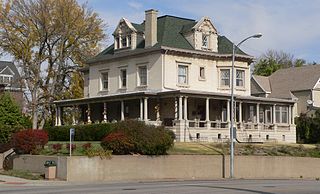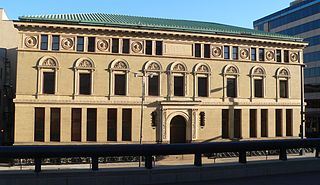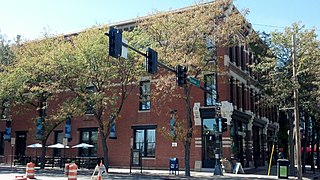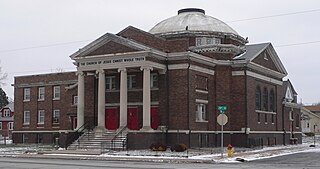
Fort Omaha, originally known as Sherman Barracks and then Omaha Barracks, is an Indian War-era United States Army supply installation. Located at 5730 North 30th Street, with the entrance at North 30th and Fort Streets in modern-day North Omaha, Nebraska, the facility is primarily occupied by Metropolitan Community College. A Navy Operational Support Center and Marine Corps Reserve unit, along with an Army Reserve unit occupy the periphery of the 82.5 acres (33.4 ha) fort. The government deeded all but four parcels of the land to Metropolitan Community College in 1974.
Architecture in Omaha, Nebraska, represents a range of cultural influences and social changes occurring from the late 19th century to present.

St. John African Methodist Episcopal Church was the first church for African Americans in Nebraska, organized in North Omaha in 1867. It is located at 2402 North 22nd Street in the Near North Side neighborhood. The building is listed on the National Register of Historic Places. The building was constructed in the center of Omaha's North Side in the Prairie School architecture style. Prairie School architecture is rare, and this architectural gem in urban Nebraska is particularly unusual for being designed and built in the 1920s, after the Prairie Style's rapid loss of popularity beginning after 1914.

The Jewell Building is a city landmark in North Omaha, Nebraska. Built in 1923, it is listed on the National Register of Historic Places. Located at 2221 North 24th Street, the building was home to the Dreamland Ballroom for more than 40 years, and featured performances by many touring jazz and blues legends, including Duke Ellington, Count Basie, Louis Armstrong, Dizzy Gillespie, and Lionel Hampton.

Holy Family Church was built in 1883 at 1715 Izard Street, at the intersections of 18th and Izard Streets in North Omaha, Nebraska within the Roman Catholic Archdiocese of Omaha. It is the oldest existing Catholic Church in Omaha, and is listed on the National Register of Historic Places.

The Havens–Page House, also known as the T. C. Havens House, is a historic house built between 1900 and 1924 at 101 North 39th Street in the Gold Coast Historic District of Omaha, Nebraska. Listed on the National Register of Historic Places in 1982, this home is remarkable for its classical Georgian Revival architecture.

The Gold Coast Historic District is located in Midtown Omaha, Nebraska. Listed on the National Register of Historic Places in 1997, this historic district covers approximately a 30 block area roughly bounded by 36th, 40th, Jones, and Cuming Streets. The neighborhood housed many of Omaha's cultural and financial leaders between 1900 and 1920, taking over from Omaha's original Gold Coast in prominence.

The George and Sarah Joslyn Home, is a mansion located at 3902 Davenport Street in the Gold Coast Historic District of Omaha, Nebraska, United States. Built in the Scottish Baronial style in 1903, the Castle was added to the National Register of Historic Places in 1972. It was designated as an Omaha landmark in 1979.

Calvin Memorial Presbyterian Church, located at 3105 North 24th Street, was formed in 1954 as an integrated congregation in North Omaha, Nebraska. Originally called the North Presbyterian Church, the City of Omaha has reported, "Calvin Memorial Presbyterian Church is architecturally significant to Omaha as a fine example of the Neo-Classical Revival Style of architecture." It was designated a City of Omaha landmark in 1985; it was listed on the National Register of Historic Places as North Presbyterian Church in 1986.
The George F. Shepard House is located at 1802 Wirt Street in the Kountze Place neighborhood on the north end of Omaha, Nebraska. Built in 1903 in the Queen Anne/Beaux-Arts style, it was designated an Omaha Landmark in 1981.

Strehlow Terrace, also called the Terrace Garden Apartment Complex and Ernie Chambers Court, is located at 2024 and 2107 North Sixteenth Street in the Near North Side neighborhood of North Omaha, Nebraska. Designed by Robert Strehlow and reputed local architect Frederick Henninger, Strehlow was added to the National Register of Historic Places in 1986.

Vinton School was built as a fourteen-room elementary school in 1908 at 2120 Deer Park Boulevard in the Deer Park neighborhood of Omaha, Nebraska, United States. Designed by Omaha architect Frederick W. Clarke, Vinton School is the earliest and most elaborate example of a Tudor Revival-style school in Omaha. Designated an Omaha Landmark in June 1990, the building was listed on the National Register of Historic Places in November 1989.

The original Omaha Public Library building was built in 1891 at 1823 Harney Street in downtown Omaha, Nebraska by renowned architect Thomas Kimball. Designed in the Second Renaissance Revival style, the building was designated an Omaha Landmark in October 1978, and was listed on the National Register of Historic Places that same year.

The Broomfield Rowhouse is located at 2502-2504 Lake Street in the Near North Side neighborhood of Omaha, Nebraska. It was designed by African American architect Clarence W. Wigington, who was later regarded as a master in his field. His design for the house won a 1909 Good Housekeeping competition. The house is listed on the National Register of Historic Places.

The Bradford–Pettis House is a historic house located at 400 South 39th Street in Midtown Omaha, Nebraska. It was designated an Omaha Landmark on February 26, 1980, and added to the National Register of Historic Places on July 21, 1983.

The Poppleton Block is located at 1001 Farnam Street in Downtown Omaha, Nebraska. The building was built in 1880 for Omaha lawyer and politician A.J. Poppleton, and was designated an Omaha Landmark on July 13, 1982, and was listed on the National Register of Historic Places later that year.

The Charles D. McLaughlin House is located in the Gold Coast Historic District of Midtown Omaha, Nebraska. Designed in the Colonial Revival Style by noted Omaha architect John McDonald, it was built in 1905. The City of Omaha designated it an Omaha Landmark on March 16, 1982, and it was listed on the National Register of Historic Places in November of that same year.

The Guy C. Barton House was a very elaborate and expensive Victorian home in the Midtown area of Omaha, Nebraska, United States, a home and entertaining center of an industrialist and philanthropist. The house caught fire and was demolished in 1982.

The West Farnam Apartments are located at 3817 Dewey Avenue in Midtown Omaha, Nebraska. The building was reportedly the first luxury apartment building constructed in Omaha.

Frederick A. Henninger (1865–1944), commonly known as F. A. Henninger, was a leading architect of Omaha, Nebraska. He was born in 1865 at Albia, Iowa, and attended the Chicago Art Institute. He moved from Chicago to Lincoln, Nebraska, and in 1891 to Omaha. He worked as a draftsman for an architect in 1895 and purchased the practice in 1896. He worked as an architect in Omaha until his retirement in 1937. After retiring, he moved to Pasadena, California and died there in 1944.

















